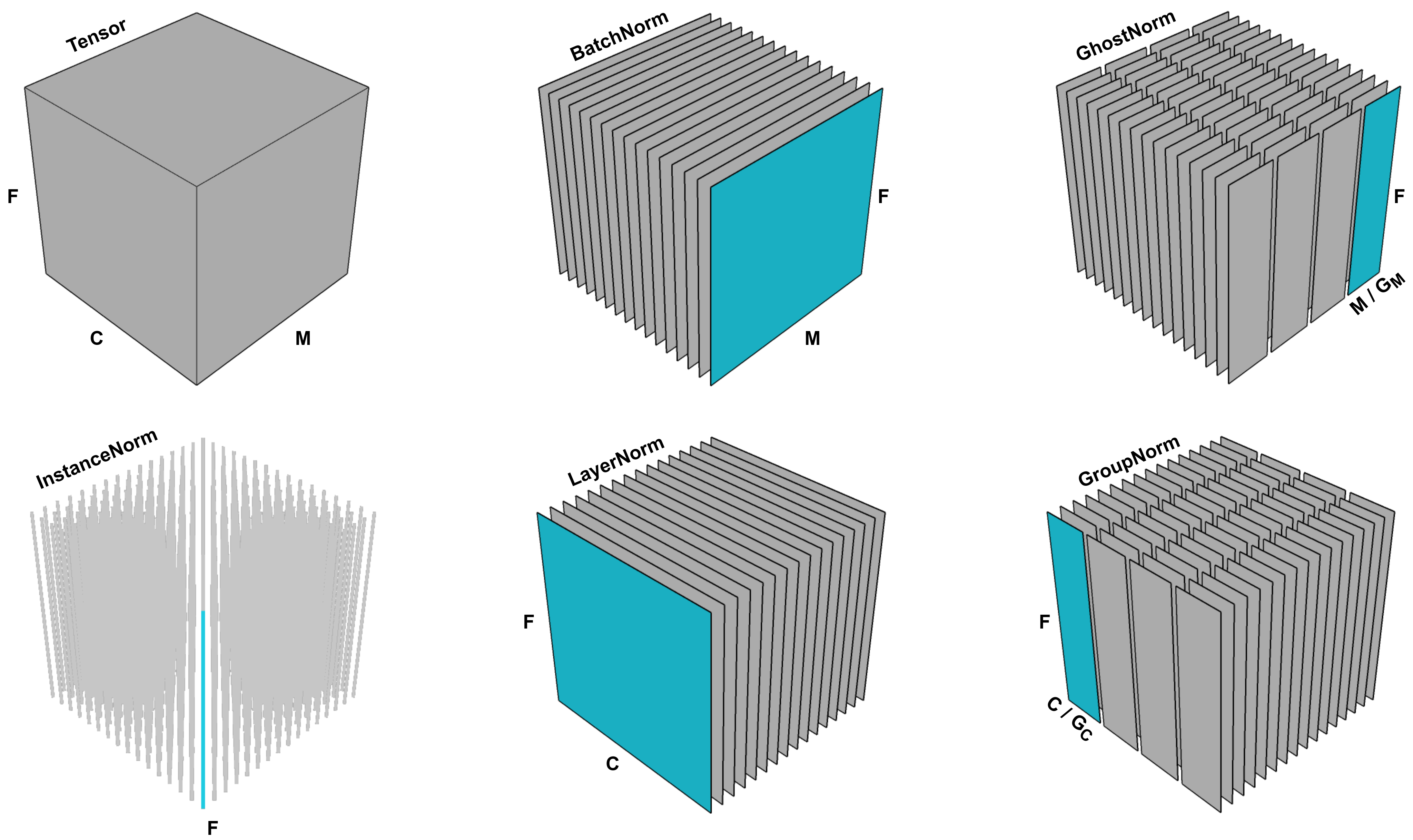👻 Ghost BatchNorm#
[How to Use] - [Suggested Hyperparameters] - [Technical Details] - [Attribution] - [API Reference]
Computer Vision
During training, BatchNorm normalizes each batch of inputs to have a mean of 0 and variance of 1.
Ghost BatchNorm instead splits the batch into multiple “ghost” batches, each containing ghost_batch_size samples, and normalizes each one to have a mean of 0 and variance of 1.
This causes training with a large batch size to behave similarly to training with a small batch size.
|
|---|
A visualization of different normalization methods on an activation tensor in a neural network with multiple channels. M represents the batch dimension, C represents the channel dimension, and F represents the spatial dimensions (such as height and width). Ghost BatchNorm (upper right) is a modified version of BatchNorm that normalizes the mean and variance for disjoint sub-batches of the full batch. This image is Figure 1 in Dimitriou & Arandjelovic, 2020. |
How to Use#
Functional Interface#
# Run the Ghost BatchNorm algorithm directly on the model using the Composer functional API
import torch
import torch.nn.functional as F
import composer.functional as cf
def training_loop(model, train_loader):
opt = torch.optim.Adam(model.parameters())
# only need to pass in opt if apply_ghost_batchnorm is used after
# optimizer creation; otherwise only the model needs to be passed in
cf.apply_ghost_batchnorm(
model,
ghost_batch_size=32,
optimizers=opt
)
loss_fn = F.cross_entropy
model.train()
for epoch in range(1):
for X, y in train_loader:
y_hat = model(X)
loss = loss_fn(y_hat, y)
loss.backward()
opt.step()
opt.zero_grad()
Composer Trainer#
# Instantiate the algorithm and pass it into the Trainer
# The trainer will automatically run it at the appropriate point in the training loop
from composer.algorithms import GhostBatchNorm
from composer.trainer import Trainer
ghostbn = GhostBatchNorm(ghost_batch_size=32)
trainer = Trainer(
model=model,
train_dataloader=train_dataloader,
eval_dataloader=eval_dataloader,
max_duration='10ep',
algorithms=[ghostbn]
)
trainer.fit()
Suggested Hyperparameters#
On ResNets trained on CIFAR-10 and ImageNet, we found that ghost_batch_size values of 16, 32, and 64 consistently yielded accuracy close to the baseline and sometimes higher.
Technical Details#
The Composer implementation of GhostBatchNorm uses model surgery to replace BatchNorm layers with GhostBatchNorm layers. Specifically, the following replacements happen:
BatchNorm1d->GhostBatchNorm1dBatchNorm2d->GhostBatchNorm2dBatchNorm3d->GhostBatchNorm3d
Each of the above GhostBatchNorm layers works by splitting an input batch into equal-sized chunks along the sample dimension and feeding each group into a normal BatchNorm module of the original type. The normal batchnorm uses a modified momentum for its running mean and variance equal to float(original_momentum) / num_chunks.
🚧 Running Mean and Variances Are Calculated Differently than BatchNorm
This yields slightly different mean and variance statistics compared to using a normal BatchNorm module. The difference stems from the moving average over a sequence of groups not being equal to the true average of the groups.
For small ghost batch sizes, this method might run more slowly than normal batch normalization. This is because our implementation uses a number of operations proportional to the number of ghost batches, and each PyTorch operation has a small amount of overhead. This overhead is inconsequential when doing large chunks of “work” per operation (i.e., operating on large inputs), but can matter when the inputs are small.
This method may either help or harm the model’s accuracy. There is some evidence that it is more likely to help when using batch sizes in the thousands. The original paper on Ghost BatchNorm reports a 0-3% accuracy change across a number of models and small-scale datasets. For ResNet-50 on ImageNet, we found Top-1 accuracy changes between -.3% to +.3%.
❗ Ghost BatchNorm Slows Down Training
We observed throughput decreases of around 5% fewer samles per second for ResNet-50 on ImageNet.
🚧 Ghost BatchNorm Provided Limited Benefits in Our Experiments
In our experiments on ResNets for ImageNet, Ghost BatchNorm provided little or no improvement in accuracy and led to a slight decrease in throughput. It is possible that Ghost BatchNorm may still be helpful for settings with very large batch sizes.
🚧 Composing Regularization Methods
As a general rule, composing regularization methods may lead to diminishing returns in quality improvements. Ghost BatchNorm is one such regularization method.
Attribution#
Train Longer, Generalize Better: Closing the Generalization Gap in Large Batch Training of Neural Networks by Elad Hoffer, Itay Hubara, and Daniel Soudry. Published in NeurIPS in 2017.
A New Look at Ghost Normalization by Neofyos Dimitriou and Ognjen Arandjelovic. Posted on arXiv in 2020.
The Composer implementation of this method and the accompanying documentation were produced by Davis Blalock at MosaicML.
API Reference#
Algorithm class: composer.algorithms.GhostBatchNorm
Functional: composer.functional.apply_ghost_batchnorm()
